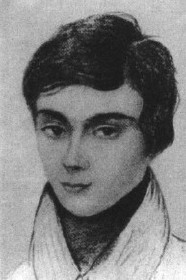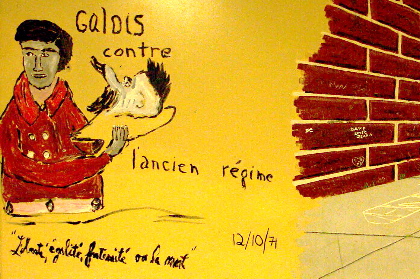Mathematics
114
Spring, 2004
email:
ribet@math.berkeley.edu
Telephone: 510 642 0648
Fax: 510 642 8204
CourseWeb
Math 114 Web Page
Enrollment
Information
9
Evans
Hall,
TuTh 3:40-5PM.
On Thursdays,
come first to 1015 Evans at 3PM to have donuts and coffee.
Syllabus
The boilerplate course description for Math 114 is as follows:
Further topics on groups, rings, and fields not covered in Math
113. Possible topics include the Sylow Theorems and their
applications to group theory; classical groups; abelian groups and
modules over a principal ideal domain; algebraic field extensions;
splitting fields and Galois theory; construction and
classification of finite fields.
The main topic of the course is undoubtedly Galois theory. We will
begin by reviewing some material from Math 113 that is relevant to
Galois theory and then spend the bulk of the semester on Galois theory
proper. If we have time left over, we will discuss the Sylow theorems
and other topics on the list that's above.
Textbook
Before choosing this book, I considered also
"Galois
Theory"
by
Jean-Pierre Escofier, from the Springer GTM series.
The Springer UTX series has
a book with the same title by
Joseph Rotman.
These texts might be good alternative sources for
some of the material that we'll be covering.
The Dover book
"Abstract
Algebra and Solution by Radicals" by John E. Maxfield
and Margaret W. Maxfield was recommended to me by
Reed Harney;
another promising book by the
same publisher is
"Galois
Theory" by
Emil
Artin.
(Please let me know if you recommend other texts on this subject that
should be added to this list.)
As preparation for this class,
you might enjoy reading
The
Galois biography on the
MacTutor
History of Mathematics Archive,
The Galois Story
by Ivars Peterson
and then
Tony Rothman's
Genius
and Biographers: The Fictionalization of Evariste Galois.
(Many thanks to Moon
for this suggestion.)
Rothman is also the author of an
earlier article
about Galois
(with the same title)
in the
American Mathematical
Monthly.
(To download this latter article, you need to be recognized as coming from
berkeley.edu. If you're working from outside the campus network,
you
can use the
library proxy server
as long as you have a UCB library card.)
Grading
Letter grades will be a function of each student's composite numerical
grade. This grade is a linear combination of the four course components:
the three exams plus the aggregate homework score.
The intention will be to make the course components count as
follows:
homework 25%, midterms 15% each, final 45%.
This class had 28 registered students (including three concurrent
enrollment students). I assigned grades
as follows: 17 A's (including some
A+ and A- grades), 7 B's, 4 C's.
One student took the course "P/NP"; the grade for that student was
converted into a "P".
See the grading table
for more
information.
Examinations
We will have three examinations in this course:
I taught this course exactly once before: in 1992.
The
first midterm,
second midterm
and
final exam
from my earlier course will give you some idea of the course's content
and might be of some help in preparing for the examinations in this
course. The midterms from 1992 were 50 minutes along, whereas our
midterms will be 80 minutes along.
Homework
Homework will be assigned weekly.
The reader is
graduate student
Emily Peters,
who has established
her own Math 114 page
for general comments on homework sets.
For most weeks,
homework will be
due on Tuesdays.
When you prepare your solutions,
write carefully, in complete
English sentences. Explain in sentences
what you are doing, even if the
problem is essentially a computation. Remember that
the
homework grader
can't guess your thoughts.
When your homework is graded, your insights are represented only by
the paper that you submitted.
Please staple your assignment together before you submit it
so that
pages won't get lost.
The question arises as to whether or not students are allowed to work
together on problem sets. In my view, this is not only fine,
but even desirable.
On the other hand, writing up solutions should be a solitary activity.
Discuss problems with other people until you really
understand what's going on. Then you can sit down alone and write down
complete solutions.
- Assignment due January 27:
Chapter 1, problems 2, 4, 7, 11. (These are on pages 14 and 15 of the
book.) Before working out the problems, look over the
comments page to check for misprints in
the book that might affect the homework problems. In problem 4,
for example, -18 should be +18 (twice).
In connection with this chapter, you might want to peek at
Curt McMullen's
classic
article
on solving the quintic equation by iteration
and possibly also at
Barry Mazur's recent book
"Imagining Numbers
(particularly the square root of minus fifteen)".
An interesting review
of the book by Keith
Devlin is available online.
I wrote up some
proposed solutions to the first homework
assignment. In the future, I may be able to write up solutions to
popular and/or interesting problems on assignments. If you'd like to
see something solved, please let me know.
As you'll see, I wrote up everything in sentences---there are formulas,
but most of what you see reads like prose. This is the style that
I hope you'll shoot for as well.
- Assignment due February 3 (discussion of the
extra problems about F, P, D):
- Let P(n) be as in Problem 1.11. Let F(n) be the nth
Fibonacci number: F(1)=F(2)=1, F(3)=2, F(4)=3, F(5)=5, and so
on. (See
The First
100 Fibonacci Numbers for more values.)
Consider the differences D(n) := 2P(n)-F(n+2).
Tabulate enough differences
D(n) so that you get a sense of the sequence {D(n)}.
Prove that D(n) = D(n+1)+D(n-1) for each positive integer n
and that D(n) takes only the three values 0, -1, 1.
- (continuation) Show that P(n+1)/P(n) and F(n+1)/F(n) have the
same limit as n->infinity. (It is well known, and presumably proved
in Math 55, that F(n+1)/F(n) approaches the Golden Mean 1.68... as
n approaches infinity.)
- Problems from Chapter 2 (pp. 27-29): 2.7, 2.8, 2.14 (a-f).
- Problems from Chapter 3 (pp. 46-48): 3.1 (ace), 3.2 (ace), 3.3 (e), 3.4.
In my lecture on January 29, I mentioned "The Fundamental Theorem of
Algebra" by
Fine
and Rosenberger. You can get some sense of it from the
publisher's
web page for the book.
- Assignment due February 10
(discussion of some
problems):
Problems 3.5, 3.6, 3.8 (b,d,f), 3.12, 3.15, 3.16,
4.4, 4.6, 4.7.
- Assignment due February 17:
4.8, 4.9, 4.10, 5.1, 5.2, 5.3, 5.4, 5.8, 5.9, 6.1, 6.3.
- Assignment due February 24
(discussion of
problem 6.11):
6.7, 6.8 (for polynomials of
degree > 1), 6.9, 6.11, 6.12, 6.14.
- Assignment due March 2
(discussion of some
problems):
6.15, 6.16, 6.17, 8.1, 8.2, 8.5, 8.12
(parts a through d). We are going to skip chapter 7 (at least for now),
discuss the first part of chapter 8 and then move on to chapter 9.
- Assignment due March 9: 9.1, 9.2, 9.5, 9.6, 9.8, 9.9.
[The grader is looking for feedback from you on the grading that she has
done so far. Are her comments helpful? Should she criticize your style as
well as the content? If you have feedback, please add it to the
comments page.]
- Assignment due March 16: 10.3, 10.5, 11.1, 11.2, 11.3, 11.6, 11.7.
- Assignment due March 30
(discussion of the
"part c" problems):
12.3, 12.4, 12.6, 13.1c, 13.2c, 13.3c, 13.9, 13.10.
- Assignment due April 6:
14.1, 14.2, 14.3, 14.6, 14.7, 14.8, 14.10, 14.13.
- Assignment due April 13:
15.1, 15.3, 15.5
- Assignment due April 20:
Let K be the extension of Q gotten by adjoining the positive square
root of the number a = (6 + 2 sqrt(5)). Calculate the Galois group of the
extension L:Q, where L is the splitting field of the minimal polynomial
of the square root of
a. List the subgroups of this Galois group and find the
corresponding fixed fields. Also, do problems 15.6, 15.7, 15.9, 15.12,
and problems 16.4 and 16.11
(discussion of two questions).
- Assignment due April 27
[average 15/20]:
17.5, 17.6, 17.8, 17.9, 17.10, 17.13, 17.14.
- Assignment due May 4:
20.1 (except for the last number); 20.2; 20.5; 20.7 for n = 8, 9, 41
and 49; 20.11; 20.12.
- Assignment due May 11.
Anonymous Feedback
Please let me know what I'm doing right and what I'm doing wrong.
Constructive feedback is always welcome;
don't hesitate to propose changes.
You might be inspired by the
comments that were made by
students in Math H113
one year ago
and by
those that were made
by the Math H110 students last semester.
You can read
the comments that have been
submitted for this course so far.






